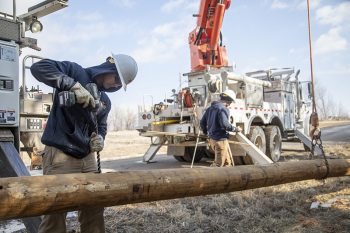

Reliability is one of the hallmarks of public power and of OPPD.
And it’s the reason why Marty Jastram is out in a horse pasture holding a plumb bob up to a clear blue sky to make sure a pole being set by a digger derrick truck is lined up straight.
A plumb bob is a course string with a weight at the end. Line technicians use them to check whether a pole or other construction is “plumb,” or vertical. Plumb bobs reportedly date back to the ancient Egyptians
Jastram, a working line crew leader in Transmission & Distribution out of the Louisville Service Center, is taking advantage of a string of mild February days to replace 100 distribution poles in the rural area south of Omaha.
“Any other year, we wouldn’t be out here doing this,” said Jastram. “Frost here was only 6 to 8 inches deep, and that’s on the north side, where we don’t get as much sun. Over by Ashland the frost is still 3 feet deep into the soil.”
Reducing outages
A lot of things can cause power outages, including storms, vehicle crashes and small animals. Failing or outdated equipment is part of that list, too. Regular system maintenance is a big part of keeping outages at a minimum.
To maintain a healthy system, OPPD has programs like GLIT (Ground Line Inspection and Treatment program) and TDIP (Transmission and Distribution Improvement Program) along with a vegetation management program.
Some of those efforts are more noticeable than others. Once a year, OPPD inspects transmission lines and structures with a helicopter. OPPD’s tree trimming contractors can be seen in neighborhoods wherever there is mature tree growth near power lines.
Not quite as noticeable, but just as important, is the GLIT program. Most people don’t notice the work, unless a pole that needs inspection has flowers planted around it. Planting or landscaping around OPPD equipment is never a good idea; OPPD has a commitment to the entire service territory to keep its equipment healthy and resilient, which may mean digging around poles.
Replacing power poles
The GLIT program involves inspecting OPPD’s distribution poles – more than 240,000 poles –from top to bottom, and about 18 inches underground, said Josh Reimers, senior engineer in Asset Management and Maintenance Optimization at OPPD. The poles that make up the overhead portion of the distribution system are on a 10-year inspection schedule.

Jastram, working at the horse farm just east of Plattsmouth, points out the pole the crew removed that morning. The part of the pole that had contact with the ground is clearly rotting away.
“We will be at these all day every day until something else comes up,” he said.
Had it been much warmer, Jastram’s crew wouldn’t have been able to get their two trucks back there and would have had to work with smaller, lighter equipment designed to go into backyards.
The owners of the horse farm took down their electric fences to let the trucks get through because the ground was still cold enough that the trucks wouldn’t cause divots on the horse run, which could injure the horses.
Wear and tear
The wooden distribution poles are exposed to all kinds of weather conditions, along with the occasional car crash. But aging and degradation are the biggest threat to the power poles.

The poles are treated with a preservative, but that doesn’t last forever. In years 13 and 14 in particular, poles can start to degrade more quickly. That is when the treatment in the pole deteriorates and needs to be renewed through the GLIT program. Inspectors take small core samples – about the size of a cork – out of the pole to test its interior health.
If a power pole is degraded below two-thirds or more of its original strength, it is at higher risk of failure.
A pole that has reached the end of its life is “red tagged” by an OPPD contractor, and once all the lines are off (phone and cable companies also use the poles) the pole is removed. A new pole is set before that happens and OPPD puts its lines and equipment on it first.
Improving efficiency
New software has changed how the GLIT program works and has made the process more efficient.
Before adopting the software, if there were 200 poles that needed to be replaced in an area, then 200 material requests would be processed at the warehouses. Now those same 200 requests can be bundled into one material request and the material loaded onto one flatbed trailer.

“Our replacement methodology is based on efficiency,” said Reimers. “We try to bundle the work in an area, so there isn’t a lot of mobilization or time wasted driving around.”
Reimers said the replacements used to be done by entirely by circuit, where a circuit’s poles would be replaced and then crews move on to another circuit. But in the last year, with the acquisition of new software, a database has been created that shows where all the poles are.
“This database allows us to put all the poles on the map, so now I can lasso the poles to do it by area,” Reimers said. “Now I can go block by block and street by street and create a report rather than just looking at the circuit level.”
Customer focused

The budget for the GLIT program has increased in recent years, from $2.8 million in 2018 to $6.5 million in 2022. Historically, there has been a backlog of poles to replace, because the work is usually fit in between bigger jobs. But that is changing, and it is making a difference.
In 2022, 1,193 poles were replaced. That’s the second-highest total going back to 2008, when only 103 poles were replaced. The highest total came in 2021, with 1,250 poles replaced.
“To the customer-owner, it aides in our distribution system’s resiliency,” Reimer said. “So when that storm rolls in, there is more assurance our poles won’t come down,” Reimers said.
Crews like Jastram’s will keep chipping away and replacing the red-tagged power poles. And fewer downed poles means fewer outages.

Jason Kuiper joined OPPD as a communications specialist in 2015. He is a former staff writer and reporter at the Omaha World-Herald, where he covered a wide range of topics but spent the majority of his career covering crime. He is a graduate of the University of Nebraska at Omaha and has also appeared in several true crime documentary shows. In his free time he enjoys cooking, spending time with his wife and three children, and reading crime novels.
View all posts by Jason Kuiper >







